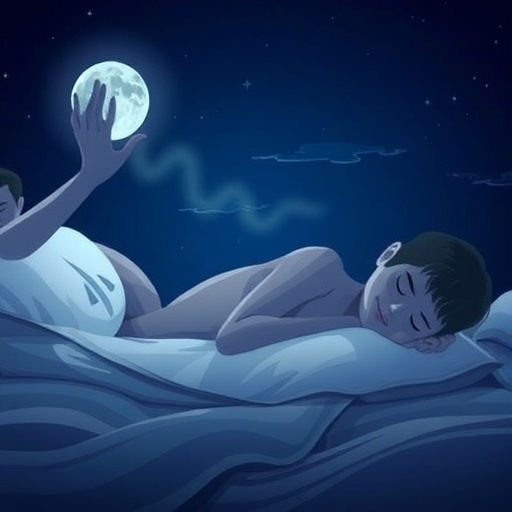In a groundbreaking study published in BMC Psychiatry in 2025, researchers have unveiled compelling evidence that nocturnal hypoxia—a condition characterized by reduced oxygen levels during sleep—plays a pivotal role in moderating the relationship between rapid eye movement (REM) sleep and the development of anxiety symptoms. This research sheds new light on the intricate interplay between sleep physiology and psychological health, offering potential pathways for novel therapeutic interventions targeting sleep-related disorders.
Sleep disturbances have long been linked with a spectrum of neurological and psychological conditions, with REM sleep anomalies frequently observed in patients experiencing mood and anxiety disorders. REM sleep, a critical phase associated with dreaming and memory consolidation, appears to be a sensitive biological window where disruptions can have profound effects on mental well-being. The current investigation expands this understanding by incorporating the impact of nocturnal hypoxia, a factor frequently overlooked in the context of psychological symptomatology.
The study analyzed data from 160 participants who presented with complaints of sleep problems. Using comprehensive overnight polysomnography, the researchers meticulously recorded oxygen saturation levels alongside various sleep indices, including the proportion of REM sleep. Psychological health was evaluated through the Chinese version of the Symptom Checklist-90-R (SCL-90-R), a validated instrument capturing a broad spectrum of psychological symptoms such as somatization, obsessive-compulsive tendencies, interpersonal sensitivity, depression, anxiety, hostility, phobic anxiety, and psychoticism.
Employing hierarchical regression analyses, the research team examined how nocturnal hypoxia intersects with REM sleep parameters to influence the intensity of psychological symptoms. The analysis revealed a significant moderating effect of the cumulative duration of nocturnal hypoxia—specifically, the time spent with blood oxygen saturation levels below 95%. This interaction between hypoxic burden and REM sleep proportion was found to be particularly salient in modulating anxiety symptoms among the participants.
To address the risk of false positive findings given multiple statistical comparisons, the investigators applied the False Discovery Rate (FDR) correction. Notably, even after this rigorous adjustment, the moderation effect of nocturnal hypoxia on the relationship between REM sleep percentage and anxiety symptoms remained statistically robust. The beta coefficient of 0.312 and the corresponding F change value underscore the strength and reliability of this interaction effect.
These findings underscore the critical role of nocturnal oxygen deprivation in exacerbating or potentially precipitating anxiety symptoms in individuals who experience altered REM sleep architecture. The cumulative hypoxic exposure appears to amplify the vulnerability to anxiety, suggesting that oxygen desaturation during sleep could be a key mechanistic link in the neuropsychological pathways leading to anxiety disorders.
The implications of this research are multifaceted. Clinically, it highlights the need for comprehensive assessment of oxygen levels during sleep, especially in patients presenting with anxiety symptoms and sleep disturbances. Therapeutic strategies that alleviate nocturnal hypoxia—such as continuous positive airway pressure (CPAP) in obstructive sleep apnea—might not only improve respiratory parameters but also exert beneficial effects on anxiety symptoms by normalizing REM sleep physiology.
Moreover, this study invites deeper exploration into the bi-directional relationships between sleep, oxygenation, and psychological health. Future research might focus on elucidating the neurobiological mechanisms by which hypoxia disrupts REM sleep and how these disruptions translate into anxiety pathogenesis. Potential pathways include hypoxia-induced neuroinflammation, altered neurotransmitter dynamics, and impaired synaptic plasticity, all of which are critical to mood regulation.
The integration of hypoxia metrics into sleep studies is a promising avenue to advance personalized medicine approaches for psychiatric disorders. Understanding individual variability in hypoxic burden and sleep patterns could guide tailored interventions, enhancing treatment efficacy and improving quality of life. As anxiety disorders remain among the most prevalent and debilitating mental health challenges globally, insights gained from this line of research could have widespread public health impact.
Importantly, this investigation provides a foundational framework that connects physiological sleep abnormalities with psychological symptom expression through a modulating hypoxic factor. Such integration of respiratory and neurological parameters pushes the boundaries of conventional sleep research, advocating for multidisciplinary approaches to untangle the complexity of mental health disorders.
The study’s design, leveraging objective polysomnographic data and validated psychological assessments, ensures a rigorous and scientifically sound foundation for its conclusions. However, the authors acknowledge the necessity for longitudinal studies to determine causality and the directionality of these associations. Understanding whether nocturnal hypoxia precedes or exacerbates REM sleep disturbances and anxiety could inform preventative strategies.
In conclusion, Jiang and colleagues have contributed a significant advancement in our understanding of the interrelation between REM sleep, nocturnal hypoxia, and anxiety. Their findings pave the way for innovative clinical screening and intervention paradigms, highlighting nocturnal oxygenation as a critical factor in mental health. This research not only enriches the scientific discourse on sleep and psychology but also offers hope for improved treatments for those suffering from anxiety and sleep disorders.
Subject of Research: The moderating role of nocturnal hypoxia on the relationship between rapid eye movement sleep and anxiety symptoms.
Article Title: Nocturnal hypoxia moderates the relationship between rapid eye movement sleep and anxiety.
Article References:
Jiang, F., Li, T., Huang, J. et al. Nocturnal hypoxia moderates the relationship between rapid eye movement sleep and anxiety. BMC Psychiatry 25, 952 (2025). https://doi.org/10.1186/s12888-025-07440-9
Image Credits: AI Generated




